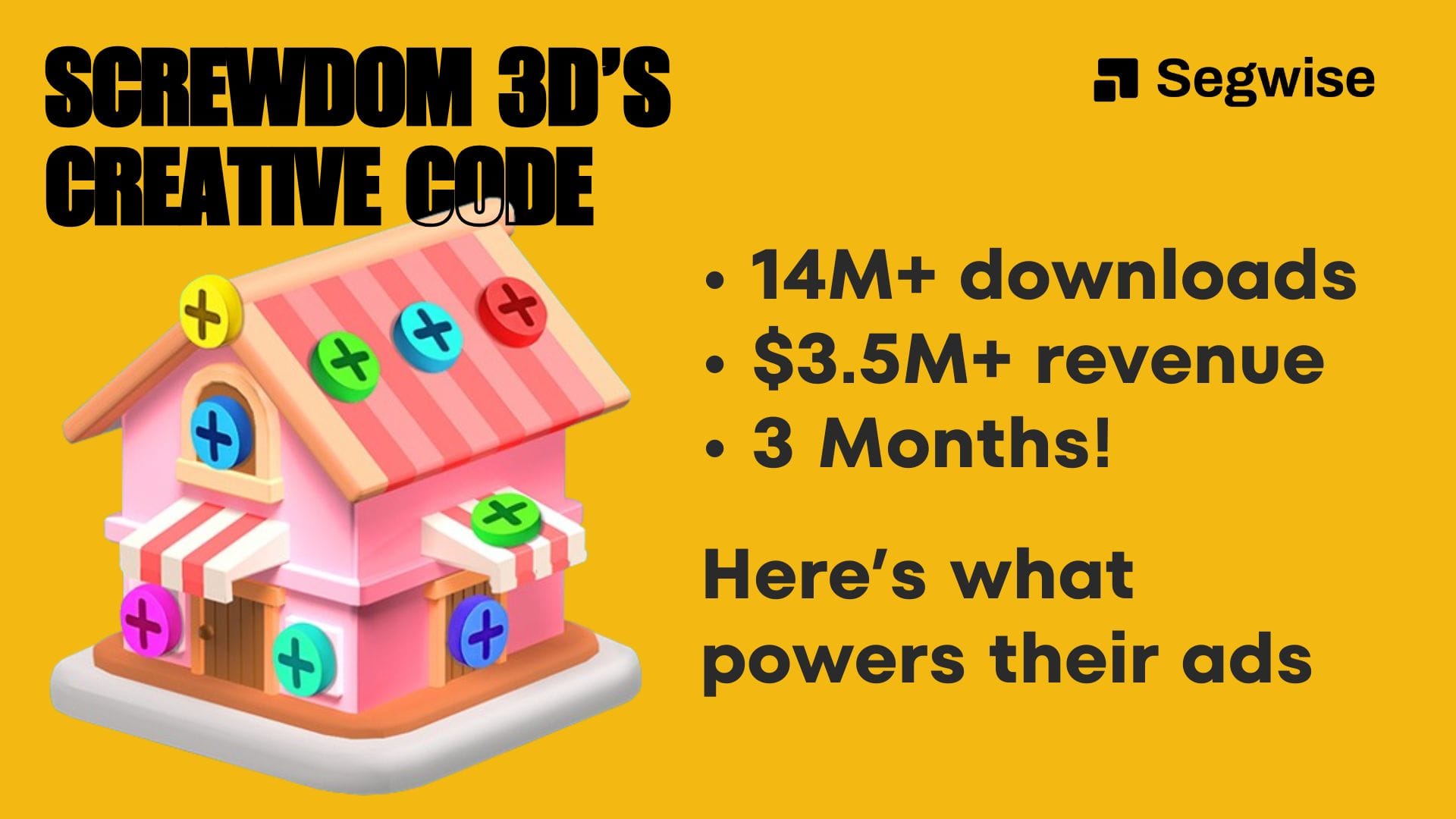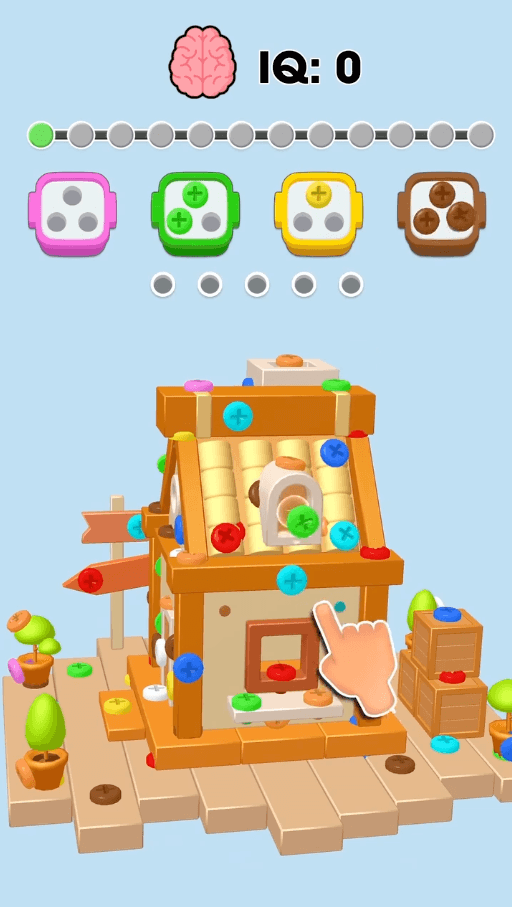How Screwdom 3D Cracked the Creative Code: 4 Patterns Behind its Success

Introduction:
Every performance marketer knows the feeling: a campaign looks great on paper, but the creative just doesn’t land. You’ve optimized the bid, nailed the targeting, but your CTRs? Flat. CPI? Through the roof.
What if you could reverse-engineer a winning formula from a breakout success?
That’s exactly what we did with Screwdom 3D - a hyper-casual puzzler that pulled off 14M+ downloads and $3.5M+ in revenue in just 3 months. We analyzed Screwdom's top performing creatives using Segwise’s AI-powered tagging engine, spanning 15 countries and 7 ad networks.
We uncovered 4 clear patterns you can steal today. Whether you’re running playables, videos, or hybrids - this breakdown will give you the cheat codes to scale faster and waste less time testing dud concepts.
Also see What Makes Color Block Jam’s Ads a $23M Success
1. Lead with Gameplay, Not Gimmicks
💡 100% of Screwdom 3D’s top creatives were gameplay-focused.
Why it works:
- Familiarity breeds clicks: Viewers recognize mechanics instantly.
- Clarity over complexity: Simple ads = faster comprehension.
- Guiding hand = emotional pull: Audiences feel like they're playing.
“It’s like giving your user a spoonful of the game without letting them taste the ending. Curiosity drives the conversion.”
Pro Tip:
Show a guiding hand solving a core mechanic (like unscrewing a bolt), then cut mid-action. That cliffhanger does more than any CTA.
2. The Perfect Combo: Video First, Playable Next
🎮 80% of Screwdom’s top video creatives were immediately followed by a playable ad.
Why it works:
- Tease, then satisfy: Video primes interest, playables seal it.
- Improves ad funnel depth: Video builds intent, playables convert.
- Better ROAS: Players self-qualify by engaging with gameplay before install.
Pro Tip:
Don’t run videos standalone. Always follow with a playable ad.
3. Mid-Gameplay Cutoffs: Leave Them Wanting More
✂️ 80% of playables cut off in the middle of the playing experience.
Why it works:
- Psychological tension: Viewers crave resolution.
- Improves retention-to-store: Curiosity creates forward momentum.
- Simpler to produce: You don’t need full story arcs.
Pro Tip:
Showcase a challenging moment and stop just before the payoff. Think of it like the Zeigarnik Effect in action.
4. Hook Variety: Calm Minds or Challenge Mode
🧠 60% of top ads used challenging hook text ("Only 1% can solve this"), but calming hooks like "Let your mind rest for a while" were introduced in the last 30 days and also performed well.
Why it works:
- Emotional segmentation: Challenge vs. peace appeals to different mindsets.
- Scroll-stopping contrast: Calming hooks stand out amid hype.
- Audience expansion: Not everyone responds to competitive tone.
Pro Tip:
A/B test both challenge- and calm-based copy. Track ROAS across cohorts.
Emerging Trends to Watch
- UGC-style hooks before gameplay footage
- Themed objects like different home styles, libraries and animals freshen visual appeal
- IQ counters and progress bars act as subtle psychological triggers
“Progress bars and IQ meters are the new power-ups, they hijack our need to measure ourselves.”

Pro Tip:
Even a fake IQ counter can enhance perceived value. Just suggest it might be measuring something.
Final Cheat Sheet: Steal These 4 Moves
Creative Element | What to Do |
|---|---|
Gameplay + Guiding Hand | Show core mechanic with a helping hand, cut mid-task |
Video + Playable | Use short gameplay teaser, follow with playable |
Hook Variety | Test “challenging” vs “calming” headlines |
IQ & Progress Meters | Add visual elements that suggest measurement |
Source: Segwise.ai creative agent. Creative source via AppMagic.
Wrapping It Up: Pattern > Luck
Screwdom 3D didn’t go viral by chance. They built creatives with:
- Predictable psychological hooks
- Strategic ad sequencing
- Clear, gameplay-first visuals
Want to find your next winning creative pattern? Segwise.ai can tag and analyze your top 50 creatives in minutes.
FAQs
Q1: What is a "guiding hand" in ad creatives? A: It refers to an on-screen hand or pointer that visually guides the viewer through a task, making the gameplay feel interactive and intuitive.
Q2: Why end a creative mid-gameplay? A: Cutting off an ad mid-task builds psychological tension (Zeigarnik Effect), increasing curiosity and click-through rates.
Q3: What tools were used for this analysis? A: Segwise.ai’s AI-powered tagging engine was used to analyze Screwdom's top creatives across networks and countries from Jan-March 2025.
Q4: Are calming hooks better than competitive ones? A: It depends on your audience segment. Calming hooks can appeal to casual players, while competitive ones trigger challenge-driven users. A/B test both for your app.
Q5: How do IQ counters and progress bars help? A: They tap into the user's desire for self-assessment and progression, increasing engagement even if they're arbitrary.
Q6: Can I replicate this strategy for non-hypercasual games? A: Yes, but adapt the core principle: show real gameplay, use interactive triggers, and sequence content smartly (e.g., teaser video → playable).

Comments
Your comment has been submitted successfully!